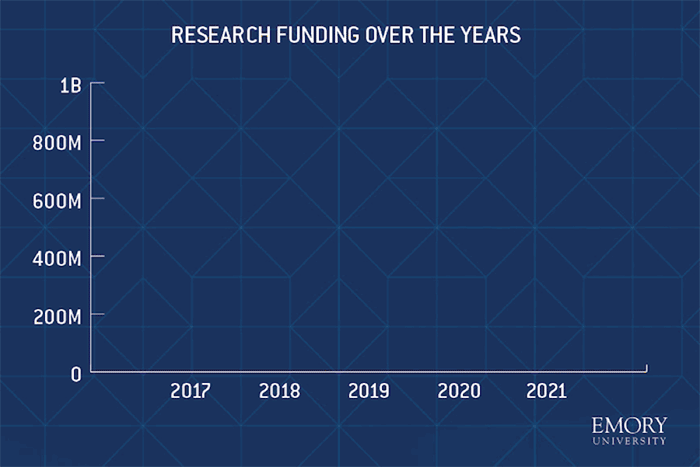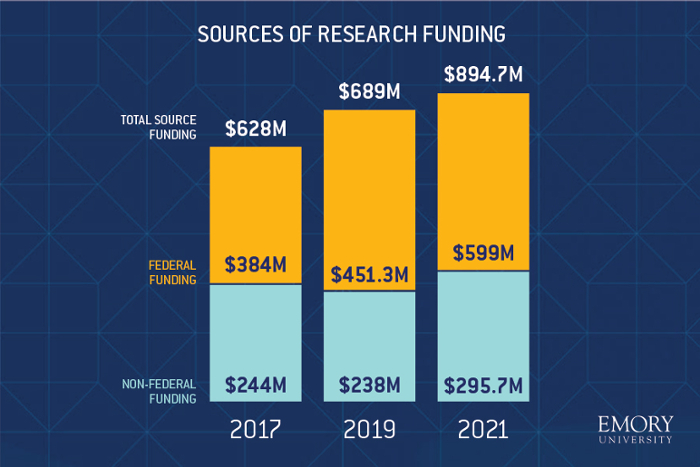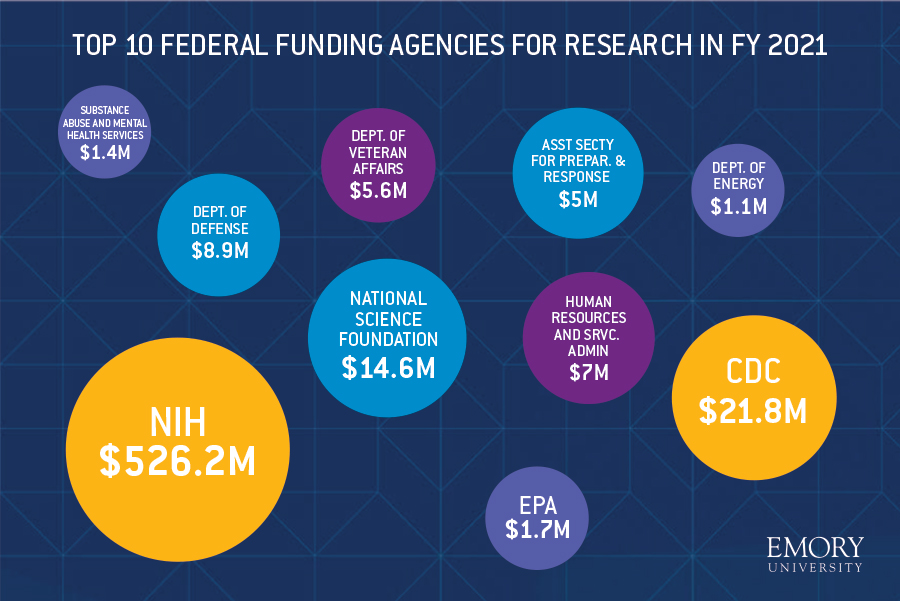Emory University attracted record support for its research, receiving $894.7 million in fiscal year 2021 for tackling the challenges of our time. Investigators won grants for developing and evaluating COVID-19 vaccines, tests, and treatments; exploring new frontiers of the mind; addressing climate change; and advancing ideas and solutions to end health disparities and promote racial and social justice.
This is the second straight year in which Emory has topped its previous best. Research support has grown by more than 55 percent over the last five years, and 2020 marked the first time funding crossed $800 million. This year’s funding represents a 7.6 percent increase over last year’s high of $831.2 million.
“To achieve this milestone for research funding, especially during a year defined by so many unprecedented challenges, is a testament to the commitment and dedication of Emory’s faculty and researchers,” says Emory President Gregory L. Fenves. “They were called upon like never before and they rose to the occasion, delivering brilliant, forward-thinking research and setting a new standard for what this academic community can accomplish.”
The lion’s share of funding for Emory’s research enterprise this year came from federal agencies which contributed $598 million. The National Institutes of Health (NIH) led the sector with $526 million to tap into Emory’s long and deep expertise in infectious diseases, bacterial resistance, cancer, and the neurosciences. The other top sources of federal funding were the Centers for Disease Control and Prevention, National Science Foundation, and the Department of Defense. This year, Emory also won its highest ever awards from the U.S. Environmental Protection Agency, the Department of Veterans Affairs, and the National Endowment for the Humanities.
Contracts and awards from industry sponsors accounted for $78 million, while funding from the state of Georgia totaled $14 million. Contributions from private and non-profit organizations jumped the most year over year, climbing 48 percent to $131 million.
A significant driver of this year’s research growth came from increased funding to medicine, public health, and nursing. Awards to entities within Emory’s Woodruff Health Sciences Center (WHSC) made up $847M of the total; the School of Medicine recognized the largest dollar increase in funding, up $42 million from the previous year for a total of $607 million. Emory’s Rollins School of Public Health ($127 million), Yerkes National Primate Research Center ($88 million), Emory College ($42 million), and the Nell Hodgson School of Nursing ($20 million) rounded out the top five recipients.
“I am both humbled and impressed with the high-impact research conducted this past year by our faculty and research teams,” says Jonathan S. Lewin, Emory executive vice president for health affairs and executive director of WHSC. “This year’s spectacular growth accentuates Emory’s reputation as a research powerhouse and, despite the pandemic, underscores our commitment to the health sciences by improving lives and providing hope to everyone we serve through discovery and innovation.”
Emory faculty and staff set a new high for the number of successful proposals that were awarded funding (3,669). Collaborative research, which brings experts together from different fields of study to address large, complex issues, continued to attract sizeable attention from funders.
“These numbers mean important financial support for research across schools and centers,” says Deborah W. Bruner, senior vice president for research at Emory. “More than that, the numbers remind us of the power of constructive collisions—conversations springing up across disciplines that spark new ways of thinking, seeing, and impacting our world.”
Bruner points out that none of these gains would be possible without the contributions of faculty who “lead the way from bench to bedside, from the classroom to the community.” “Our researchers have once again shown us what real heroes look like,” she says. “Despite the challenges posed by research ramp-down and up, remote work, and a shifting public health landscape, our faculty led with creativity and resilience, forging new partnerships within and beyond Emory and making breakthroughs across the university’s signature areas of inquiry.”
Ending a pandemic
Emory is expected to continue to rank first among universities in the state for NIH’s COVID-19 research funding. COVID-19 funding made up 12 percent of the year's total research funding, and rose by almost a third over the previous year. Aided by researchers at the Emory Vaccine Clinic and its clinical arm, The Hope Clinic, the NIH-funded Infectious Diseases Clinical Research Consortium, with leadership at Emory, has become a pivotal network for evaluating vaccines and treatments for the coronavirus. Emory has been involved in testing all three vaccines that are currently in use.
“The contributions of Emory researchers in addressing the pandemic, including work on new COVID-19 diagnostics, therapies and vaccines and in defining the health inequities magnified by the pandemic, have been exceptional. The funding is a reflection of the national and global impact of these investigators” says David S. Stephens, vice president for research of WHSC.
In the area of drug development, Molnupiravir, an antiviral medication first discovered at Emory’s non-profit drug development company DRIVE (Drug Innovation Ventures at Emory), was shown to reduce SARS-CoV-2 to undetectable levels in COVID-19 patients after five days of administration in early-stage trials. The Emory-patented anti-inflammatory medication baricitinib, first repurposed by Emory’s Raymond Schinazi, is emerging as a major option for treatment of hospitalized COVID-19 patients needing respiratory support.
Below are a few research projects addressing COVID-19:
- Evaluating COVID-19 tests that can be brought to market rapidly and recommending strategies for scaling up testing. The project brings together researchers from Emory, Georgia Tech, and Children’s Healthcare of Atlanta. (Wilbur Lam and Greg Martin)
- Testing wastewater for SARS-CoV-2 in partnership with Ceres Nanosciences. The NIH-funded study will focus on underserved and vulnerable populations around the Atlanta community where the burden of COVID-19 may be under-recognized. (Christina Moe, Pengbo Liu, and Leda Bassit)
- Investigating COVID-19 immune responses in patients with cancer or autoimmune diseases.(Ignacio Sanz and Madhav Dhodapkar)
- Exploring the intersection of COVID-19 and recent police protests. (Andra Gillespie)
- Developing a real-time contact tracing app for COVID-19. (Li Xiong)
- Investigating factors contributing to the risk of developing long COVID – the lingering health effects of a SARS-CoV-2 infection – and unraveling why it occurs and why it affects some more than others. (Frances Eun-Hyung Lee and Alex Truong)
Beyond COVID-19
Emory faculty made important advances in areas outside the pandemic, from the basic sciences to the clinical and social sciences, from the creative arts to business and theology. Below are some highlights:
- Partnering with Atlanta area experts to understand the long-term effects of slavery, Jim Crow, and ongoing systemic racism on the Black community in the city. The long-term goal includes developing a scalable model for university-community partnerships that promote justice, specifically local reparations. (Carol Anderson, Vanessa Siddle Walker, Janeria Easley, and Jessica Stewart)
- Investigating the complex interactions between glaciers, sea ice and the ocean to help predict the effects of climate change on sea level rise. (Justin Burton)
- Measuring environmental contaminants and exposure among children in West Atlanta to understand and help mitigate its health impact. (Eri Saikawa and Dana Barr)
- Establishing the Brain Health Personalized Medicine Institute to understand the root causes of diseases such as Alzheimer’s by examining patients’ biological, medical and lifestyle factors. (Allan Levey)
- Using a multi-disciplinary approach to helping identify biomarkers that predict maternal morbidity and mortality among expecting Black mothers during labor. (Nicole Carlson)
- Studying racial disparities in mortality and educational attainment. (Angela Dixon)
- Finding new therapeutic approaches to fragile X (Peng Jin)
- Accelerating research to cure HIV infection or halt its progression through a collaborative approach. (Deanna Kulpa, Mirko Paiardini, and Guido Silvestri)
- Understanding heteroresistance, a particular form of antibiotic resistance that undermines treatment of bacterial infections (David Weiss and Bruce Levin)
- Helping congregations implement new approaches to community engagement, theological study, and leadership. (Ryan Bonfiglio)
- Uncovering Atlanta’s racial history and offering a clearer look at the Atlanta Race Massacre of 1906 using a journalistic and historical lens. (Hank Klibanoff)
- Expand the pioneering work of the Emory-based Sounding Spirit research laboratory to draw on a rich historical corpus of Southern sacred songbooks to highlight relationships between race, place, religion, and culture central to national conversations. (Jesse P. Karlsberg)
- Reducing child mortality by understanding the causes of death in children under five worldwide. (Cynthia Whitney)



